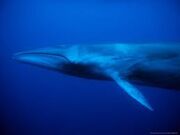
The Sei Whale is a baleen whale, the third-largest rorqual after the blue whale and the fin whale. It inhabits most oceans and adjoining seas, and prefers deep offshore waters. It avoids polar and tropical waters and semi-enclosed bodies of water. The sei whale migrates annually from cool and subpolar waters in summer to winter in temperate and subtropical waters. Following large-scale commercial whaling during the late-nineteenth and twentieth centuries, when over 255,000 whales were taken, the sei whale is now internationally protected, although limited hunting occurs under controversial research programmes conducted by Iceland and Japan. As of 2008, its worldwide population was about 80,000, nearly a third of its pre-whaling population.
Description[]
The sei whale is the third-largest balaenopterid, after the blue whale (up to 180 tonnes, 200 tons) and the fin whale (up to 70 tonnes, 77 tons). In the North Pacific, adult males average 13.7 m (45 ft) and adult females 15 m (49 ft), while in the North Atlantic adult males average 14 m (46 ft) and adult females 14.5 m (47.5 ft). In the Southern Hemisphere they average 14.5 (47.5 ft) and 15 m (49 ft), respectively. In the Northern Hemisphere, males reach up to 17.1 m (56 ft) and females up to 18.6 m (61 ft), while in the Southern Hemisphere males reach 18.6 m (61 ft) and females 19.5 m (64 ft). The largest specimens taken off Iceland were slightly longer than 16 meters (52 ft). The longest measured by Discovery Committee staff were an adult male of 16.15 m (53 ft) and an adult female of 17.1 m (56 ft), both caught off South Georgia. Adults usually weigh between 15 and 20 metric tons — a 16.4 m (53.7 ft) pregnant female caught off Natal in 1966 weighed 37.75 metric tons (minus 6% for loss of fluids during flensing). Females are considerably larger than males. At birth, a calf typically measures 4–5 meters (13–16 ft) in length.
Food[]
This rorqual is a filter feeder, using its baleen plates to obtain its food by opening its mouth, engulfing large amounts of the water containing the food, then straining the water out through the baleen, trapping any food items inside its mouth. In the North Atlantic, it feeds primarily on calanoid copepods, specifically Calanus finmarchicus, with a secondary preference for euphausiids, in particular Meganyctiphanes norvegica and Thysanoessa inermis. In the North Pacific, it feeds on similar zooplankton, including the copepod species Neocalanus cristatus, Neocalanus plumchrus, and Calanus pacificus, and euphausid species Euphausia pacifica, Thysanoessa inermis, Thysanoessa longipes, and Thysanoessa spinifera. In addition, it eats larger organisms, such as the Japanese flying squid, Todarodes pacificus pacificus. and small fish, including members of the Engraulis (anchovies), Cololabis (sauries), Sardinops (pilchards), and Trachurus (jack mackerels) genera. Some of these fish are commercially important. Off central California, the whale may feed on anchovies between June and August, and on krill (Euphausia pacifica) during September and October. In the Southern Hemisphere, prey species include the copepods Neocalanus tonsus, Calanus simillimus, and Drepanopus pectinatus, as well as the euphausids Euphausia superba and Euphausia vallentini.
Habitat[]
Sei whales live in all oceans, although rarely in polar or tropical waters. The difficulty of distinguishing them at sea from their close relatives, Bryde's whales and in some cases from fin whales, creates confusion about their range and population, especially in warmer waters where Bryde's whales are most common.
